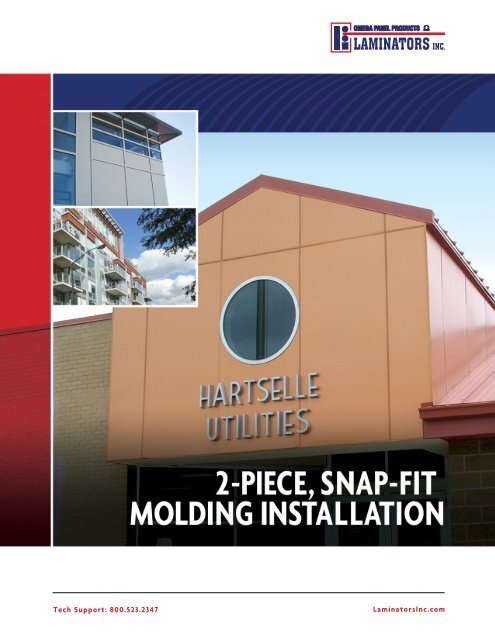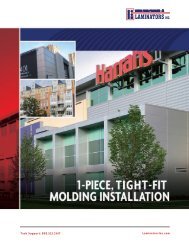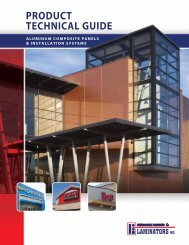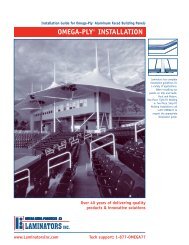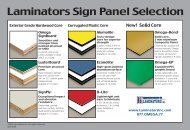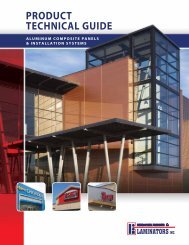2-Piece, Snap-Fit Molding - Laminators Inc.
2-Piece, Snap-Fit Molding - Laminators Inc.
2-Piece, Snap-Fit Molding - Laminators Inc.
You also want an ePaper? Increase the reach of your titles
YUMPU automatically turns print PDFs into web optimized ePapers that Google loves.
Tech Support: 800.523.2347<strong>Laminators</strong><strong>Inc</strong>.com
table of contents Tech Support: 800.523.23472-<strong>Piece</strong>, <strong>Snap</strong>-<strong>Fit</strong> <strong>Molding</strong>With <strong>Laminators</strong>’ 2-<strong>Piece</strong>, <strong>Snap</strong>-<strong>Fit</strong> Extruded <strong>Molding</strong> System, all molding receptors are fastened priorto panel installation. <strong>Molding</strong>s are available either color-matched to the panels or in a contrasting color.Before You Start 1Preparing the WallInstallation over Plywood Sheathing 2 – 3Installation over Gypsum with or without Building Wrap 4 – 5Mounting the Panels 6 – 7Essential Equipment and Supplies 8Additional Accessories 9 – 10Panel MaintenanceInside Back CoverPanels with Metallic Paint Finishes:The protective masking on the face of each panel should be left in place until work is complete on any given areaof an installation. However, to help ensure good color uniformity, periodically remove the masking from half of apanel (peel masking upward from the bottom of the panel) to check for color, scratches, and dents.On panels with metallic finishes, a good color match is much more difficult to achieve. In this case, two adjoiningpanels should be periodically checked by removing the masking from half of two panels as the installationprogresses. The masking should then be taped back over the panel to protect it.Should any defects be found, stop work immediately and call <strong>Laminators</strong> for assistance.When installing panels with metallic finishes, it is very important that the directional arrows on the panelmasking are oriented in the same direction.Color variation is a characteristic of Aluminum composite panels with metallic paint finishes.<strong>Laminators</strong> <strong>Inc</strong>orporated DOES NOT warrant a color match for these panels.
<strong>Laminators</strong><strong>Inc</strong>.comSubstrate and FramingPrior to installation, the installer MUST verify that theframing and substrate are in compliance with allarchitects’ specifications.Inspect BOTH primary and secondary wall framing to verifythat all girts, angles, channels, studs and sheathing andother structural panel support members and anchoragehave been installed within the following tolerances:1/4" in any 20' length vertically or horizontally1/2" in any building elevationInspect sheathing to verify that sheathing joints aresupported by framing and that installation is withinflatness tolerances. These surfaces must be even, smooth,sound, clean and dry. If the substrate or framing is notwithin architectural specifications, the installer mustsubmit a written report to the General Contractor listingconditions that are detrimental to the installation ofpanels. Do NOT proceed with installation untilunsatisfactory conditions have been corrected.Summary of Installer ResponsibilityThe Panel Installer assumes total responsibility for allcomponents of the panel installation including, but notlimited to attachment to sub-construction, panel-to-paneljoints, joints between panels and dissimilar material, andthe joint seal associated with the panel system.Installation Supplies & AccessoriesSee page 7 to be sure you are using materials that havebeen tested and approved by <strong>Laminators</strong> for use withOmega-Lite panels. Inventory all materials and accessoriesto ensure that all materials are available on-site. Call TechSupport if you need additional recommendations.Receiving and StorageExamination: Upon receipt of materials, perform a thoroughexamination to identify any damage that may have occurredduring shipping. Any damage must be noted on the bill oflading at the time of receipt.Storage: Panels are to be stored horizontally on pallets witha positive slope for drainage of water and should be coveredwith watertight and ventilated materials. Standing water willdamage panel finish.No more than 1500 pounds should be stacked on onepallet. Depending on panel size, this should be fewer than50 panels at 30 pounds per panel and less than 2-1/2 'high. Do not stack other materials on or in contact withpanels to prevent staining, denting, or other damage.Storage temperature must not exceed 120ºF (49ºC).<strong>Laminators</strong>’ warranty does not cover water damage causedby improper storage or installation. Inspect panels ondelivery, then store them on skids 8" above the ground.Place a breathable cover over them and store them in aventilated space under roof.If wet panels are discovered, uncrate them and dry themwith towels to prevent wood rotting, paint attaining oraluminum corrosion.Before you startPanel HandlingUse clean work gloves to avoid hand injury from any sharpedges and to prevent smudging of the prefinished surfaces.Although panels are shipped with protective masking onboth sides, always lift one panel completely off the nextto prevent scratches. Do not slide one panel across another.Protect panels from construction hazards. Goodconstruction practice provides for panel protection andcleaning in the contract documents. Normally these are thegeneral contractor’s responsibility. Temporary protectionmay be required if welding, cutting, sandblasting, orother potentially damaging construction activities arescheduled nearby.Cutting the PanelsOmega-Lite panels are designed to be cut to size onthe job site. Even if the panels have been received cutto size, it may be necessary to do some minor trimmingto account for areas of an elevation that may be out ofsquare. To cut Omega-Lite panels, use a circular saw witha sharp, carbide-tipped blade (40-tooth minimum).Do not remove the protective masking from the panel face.After cutting, use a screwdriver or deburring tool (seepage 7) to remove burrs or sharp edges from the panels.Carbide-tippedblade (40 tooth min.)recommendedSafety tip: Wear safety glasses when cutting!Wear gloves when handling cut edges!Ventilation is ImportantThe wood or exterior gypsum board of the substratemust be protected and ventilated. Trapped moisture cancause major damage in a short time. When mounting overexterior gypsum or masonry, use steel strapping or hatchannels to separate panels from the structure for goodair circulation.Flashing<strong>Laminators</strong> can supply flashing materials made fromaluminum sheet painted to match the adjacent panelsystem or surface.Use proper flashing technique when installing flashingwith panels.Complete CAD details and productspecifications can be downloaded fromour website <strong>Laminators</strong><strong>Inc</strong>.com1
<strong>Laminators</strong><strong>Inc</strong>.compreparing the wallPlasticreceptorSubstrateStep 1: Attach plastic receptorsAttach the black plastic receptors every 16" O.C. using galvanizedor stainless steel bugle headed screws. Screws with high profileheads will interfere with panel installation.See manufacturer’s instructions for the proper use of ice and water shield.“J” FaceplatemoldingTip: Temporarily install a “J” faceplateTemporarily install a “J” faceplate backwards into the blackplastic receptor. This will force the receptor to stay straightduring installation. If the receptor is not installed straight,you will have difficulty snapping the faceplate into it duringfinal assembly.Closed cell PVCfoam tapeStep 2: Apply closed cell PVC foam tapeApply foam tape every 16" O.C. as shown in the main drawingon the opposite page. These strips of foam tape act as a shimand help keep everything on the same plane.Note: It is important to keep the backer on the foam tapeas it is applied to avoid stretching or inaccurate placement.Closed cellPVC foam tapeSheathingPaneladhesiveStep 3: Apply panel adhesiveApply generous 3" dabs and 3/8" beads of panel adhesiveas shown in the main drawing on page 2.Many panel adhesives have a high solvent content thatevaporates as it cures. This causes the adhesive to losevolume and shrink. Applying panel adhesive next to thefoam tape will prevent the panels from being drawn intowards the plywood, ensuring that the panels willmaintain a flat appearance.3
Preparing The WallTech Support: 800.523.2347Installation Over Gypsum (With or without building wrap)A3/4" path for drainagePanel adhesiveReceptorsFoam tape16" on centertypicalSilicone caulkSteel strappingSteel squaresDetail APaneladhesive“J” <strong>Molding</strong>or Drip EdgeSteelstrappingIce &water shieldBDetail BWhen installing panels over exterior gradegypsum, with or without building wrap,remember that neither exterior gradegypsum nor building wrap are structural.For proper installation, 18 or 20 gauge steelsquares must be used to create a surface thatwill accept panel adhesive.All steel squares must be attached with lowprofile,pan head screws on all four corners.These screws must pass through the steelsquares, the exterior grade gypsum, and attachto the stud wall. <strong>Molding</strong>s must be attachedthrough the gypsum to the studs.The main drawing (upper left) depicts the layoutfor one panel at ground level. “J” <strong>Molding</strong> is shown:either “J” or drip edge moldings can be used here.The detail drawings (Detail A & B) show close-updetails from the main drawing. The instructionson the opposing page will explain this processand the purpose of each element shown in theabove drawings.4
<strong>Laminators</strong><strong>Inc</strong>.compreparing the wallPlasticreceptorSubstrateStep 1: Attach plastic receptorsAttach the black plastic receptors every 16" O.C. using galvanizedor stainless steel bugle headed screws. Screws with high profileheads will interfere with panel installation.See manufacturer’s instructions for the proper use of ice and water shield.“J” FaceplatemoldingInstallation tip: Alignment of receptorsTemporarily install a “J” faceplate molding backwards intothe plastic receptor. This will force the receptor to staystraight during installation. If the receptor is not installedperfectly straight, you will have difficulty snapping thefaceplate into it.Closed cell PVCfoam tapeStep 2: Apply closed cell PVC foam tapeApply closed cell PVC foam tape every 16" O.C. as shownin the main drawing on page 4. These strips of foam tapeact as a shim and help keep everything on the same plane.Note: It is important to keep the backer on the foam tapeas it is applied to avoid stretching or inaccurate placement.Closed cell PVCfoam tapeSteelsquarePaneladhesiveStep 3: Apply panel adhesiveApply generous 3" dabs and 3/8" thick beads of paneladhesive to steel straps. Straps should be screwed downevery 16"-24" O.C.Many panel adhesives have a high solvent content thatevaporates as it cures. This causes the adhesive to losevolume and shrink. Applying panel adhesive next to thefoam tape will prevent the panels from being drawn in5
mounting The PANELSTech Support: 800.523.2347The 2-<strong>Piece</strong>, <strong>Snap</strong>-<strong>Fit</strong> installation is not a progressive system. That is, you don’t movefrom one end of the building to another, installing a molding then a panel, then anothermolding and panel. Rather, you should lay out a grid where the joints will fall, thenfasten moldings over the entire wall. <strong>Snap</strong> a line to ensure that the bottom drip edgereceptor is perfectly straight to facilitate installation of the aluminum faceplate.When installing panels with metallic finishes, it is very important that the directional arrows on thepanel masking are oriented in the same direction.Set up a clean worktableUsing available materials (straight 2x4s, 3/4" flat soundplywood with smooth surface, or MDF plywood for precisionwork) construct a worktable at least 48" x 96" and at acomfortable working height.PaneladhesivePlasticreceptorStep 1: Apply adhesivesApply a 3/8" bead of <strong>Laminators</strong>’ approved silicone caulkinto the receptors and 3/8" bead of <strong>Laminators</strong>’ approvedpanel adhesive inside the pocket that receives the faceplate.The silicone will prevent water from getting behind the panelsand the panel adhesive will hold the faceplates in placepermanently and minimize the expansion and contraction ofthe faceplates during the normal warming and cooling cyclethat occurs each day.PlasticreceptorPaneladhesiveSiliconecaulkPanelSiliconecaulkStep 2: Attach the panelsDrill a 1/8" pilot hole in the top and bottom edge of the panel1/4" O.C. from the bottom edge of the panel. Screw panel inplace. This will hold the panel until the panel adhesive cureson the wall and in the receptors. Take care not to overdrive thescrew, as this may create a dimple that will be visible beyondthe portion of the panel covered by the faceplate. Do not usebugle head type screws here, as they may also create dimples.You may find that turning the torque setting on your drill allthe way down will help prevent dimpling.Caulk Manufacturers’ Recommendation:Panel surfaces and edges should be clean, dry and free of allcontaminants such as protective coatings, oils, grease, soapor detergent films, water and dust.6
<strong>Laminators</strong><strong>Inc</strong>.commounting The PANELSFaceplatePanelmaskingStep 3: Caulk receptorsStrip the masking back about 3" from the edges ofthe panel. Leave the rest of the masking on for nowto protect the panel until work is complete in that area.Just prior to attaching the faceplates, apply a bead of<strong>Laminators</strong>’ approved silicone caulk to all four cornersof the panel. This will seal the gaps left in the receptorsshown in the main drawings on page 2 and 4. Faceplatesshould be cut about 1/8" shorter than the distance youare spanning to allow for expansion and contraction.This gap can be top beaded with clear silicone caulk toseal the area.ReceptorsTop beadof caulk7
Essential Equipment Tech Support: 800.523.2347• Work table or saw horses and 3/4" particle boardto create work table• Aluminum brake capable of bending 0.032" aluminum• Porter-Cable 3 HP router with guide or equivalentable to accept a 1/2" carbide shank• <strong>Laminators</strong>’ router bit (Part #RB 1/2)— Custom designed router bit only available from<strong>Laminators</strong> <strong>Inc</strong>. that forces bending into themiddle of the groove and eliminates core showthrough.Carbide with 1/2" shank.• Miter saw or chop saw with 10" diameter blade• Circular saw with 7-1/4", 40-tooth blade (min.)• Jigsaw with 24-tooth, sheet metal cutting blade• Caulking gun• Screw gun• Long 1/8" drill bit with drill bit plastic guard tubing• Deburring tool (Part #DEBURRING TOOL)• Aviation snips or heavy-duty scissors• Plastic putty tool or scraper to remove excess caulkand adhesive from panels• Metal single cut rectangular file with medium teeth• Utility knife• Tape measure• Safety glasses• Gloves to handle panelsEssential Supplies• Panels• <strong>Molding</strong>s/extrusions as needed— “J” extrusion for drip edge (required)and end of run option (optional)— “H” extrusion for end of run option (optional)— snap-in extrusions (required)• Color-matched flat stock• Strapping— 0.40" aluminum or 20 ga. galvanized exteriorsheet metal strips 3" x 8', 10', or 12'• Furring strips or studs as needed• Insulation, 3/4" foam to go between furring strips• Ice & water shield or flashing• Gaska Tape® V710, 3/16" x 2" or equivalent closed cell7 lb. density polyvinyl chloride foam tape(<strong>Laminators</strong> Part #12847)• Silicone Caulk–The following caulks have been testedand meet requirements. Color-matched caulk availablefrom <strong>Laminators</strong> <strong>Inc</strong>.— Tremco Spectrem® 1— Dow Corning® 790, 983, 795, 995, 756, 791— GE SilGlaze® II , SilPruf®— Pecora 860, 896, 895Note: Minimum order quantities required forcertain color-matched caulks.• Caulking rope or backer rod; use 1/4" or 3/8" to suit job• Masking tape (Scotch brand Safe Release Masking Tapeis recommended) 1" wide• Panel Adhesive–The following adhesives havebeen tested and meet requirements. Variousadhesives available from <strong>Laminators</strong> <strong>Inc</strong>.— Titebond® Heavy-Duty Construction Adhesiveor Premium Polyurethane Construction Adhesive— Liquid Nails® 602 Subfloor (LN-602), 950Polyurethane (LN-950), 902 for Subfloor (LN-902),or 901 for Heavy Construction (LN-901)— DAP 4000 Subfloor Adhesive— OSI Sealants PL400• Screws— #6 x 1-1/4" bugle-head drywall or #8 or #10 x 1"Phillips Pan Head for securing clips into sheathing— #8 or #10 x 3/4" or longer, TEKS/3 screws to secureclips into steel studs— #6 x 1/2" and #6 x 1" Phillips Pan Head,TEKS/2 screws for mounting moldingsto plywood or metal• Wood shims to assist with spacing between panels• Mineral spirits and rags to clean caulk from panelsif necessary• Touch-up paintNote: Trademarks are registered by the companies noted.How Much Will I Need?For every 100 sq. ft. of Omega-Lite panelsyou will need:• 3 tubes 11 oz. silicone caulk• 1 tube 28 oz. panel adhesive• 3 rolls 2" x 50' closed cell PVC foam tape8
<strong>Laminators</strong><strong>Inc</strong>.comADDITIONAL accessories2-<strong>Piece</strong>, <strong>Snap</strong>-<strong>Fit</strong> <strong>Molding</strong>...for use with Omega-Lite & Omega-Ply panelsReveal “H” <strong>Molding</strong>Item 4395X: Faceplate, Item 43900: Receptor“J” <strong>Molding</strong>Item 4315X: Faceplate, Item 43100: Receptor“H” <strong>Molding</strong>Item 4305X: Faceplate, Item 43000: ReceptorOutside CornerItem 4335X: Faceplate, Item 43300: Receptor<strong>Snap</strong>-In ExtrusionsThe wall thickness for the top pieces is 0.050.Gap A, B, C indicates the three snap positionsto accommodate panel thickness.Gap Height IC HeightA) 0.215 D) 0.412 G) 1.288B) 0.265 E) 0.462 H) 1.338C) 0.315 F) 0.512 I ) 1.388Faceplates are shown in grey. Receptors are shown in black.The letter X identifies the molding color.Inside Corner (Drip Cap)Item 4325X: Faceplate, Item 43100: Receptor9
Tech Support: 800.523.23471-<strong>Piece</strong>, Tight-<strong>Fit</strong> <strong>Molding</strong>...for use with Omega-Lite panelsItem 4525X: Inside Corner (Drip Cap)Item 4535X: Adjustable (Bendable) Outside CornerItem 4595X: Reveal “H” <strong>Molding</strong>Item 4505X: “H” <strong>Molding</strong>Item 4515X: “J” <strong>Molding</strong>Item 4545: “Z” <strong>Molding</strong>The letter “X” identifies the molding color.4515X:“J” <strong>Molding</strong>4545: “Z” <strong>Molding</strong>In addition to the standard clip and caulkdetails, these standard extrusions are used byinstallers to complete attractive installations.Available plastic snap-in10Fascia Soffit or Outside Corner (“J” <strong>Molding</strong> & “Z”<strong>Molding</strong> combined with plastic snap-in molding)
<strong>Laminators</strong><strong>Inc</strong>.comNOTES11
<strong>Laminators</strong><strong>Inc</strong>.comPanel MaintenanceOmega-Lite Panel MaintenanceRoutine cleaning:Omega-Lite panels should be washed periodically to keep them bright. Plain water and a clean clothare all you need to remove ordinary dirt buildup. A mild, non-abrasive household detergent with aclean-water rinse can be used for more stubborn stains. Solvents such as alcohols, mineral spirits,naphtha, turpentine, and xylene can be applied with a soft cloth. Never soak panels in solvents.For scratches and rub-marks:Omega-Lite touch-up paint and re-paint instructions are available from <strong>Laminators</strong>. For larger paintrepairs, call <strong>Laminators</strong> for standard paints designed for aluminum surfaces available at paint stores.Keep harsh solvents away from finish:Panel finishes are resistant to most but not all solvents and chemicals. You can safely use mineral spiritsto remove uncured caulk and paints.We suggest that the caulk build up enoughstrength in an overnight cure so that bubblesdo not form.Carefully review the caulk manufacturer’s literaturefor skin formation, tack-free time, and cure timesbefore using. Remember, your environmentalcondition is the biggest factor in deciding whichcaulk is appropriate for your project. Caulk onlyone joint at a time so that the caulk does not skinover before it can be tooled. Only caulk 4' to 6'at a time for a smooth finish.It is important to only use caulk from ourrecommended list and to always test your caulkin the environmental conditions you are currentlyworking in to find the one that works best. Consultwith us if your caulk is not performing as expected.Apply a generous amount of panel adhesive to thesheathing to prevent it from drawing the paneltowards the building as it dries; closed cell PVCfoam tape should be placed out in the field of thepanel where it will shim the adhesive to the properthickness away from the furring or sheathing.13
<strong>Laminators</strong><strong>Inc</strong>.com Tech Support: 800.523.2347 3255 Penn Street · Hatfield, PA 19440©2011 <strong>Laminators</strong> <strong>Inc</strong>orporated. All rights reserved. A123 (6/11) Omega-Lite® Aluminum Building Panels Installation Guide.


